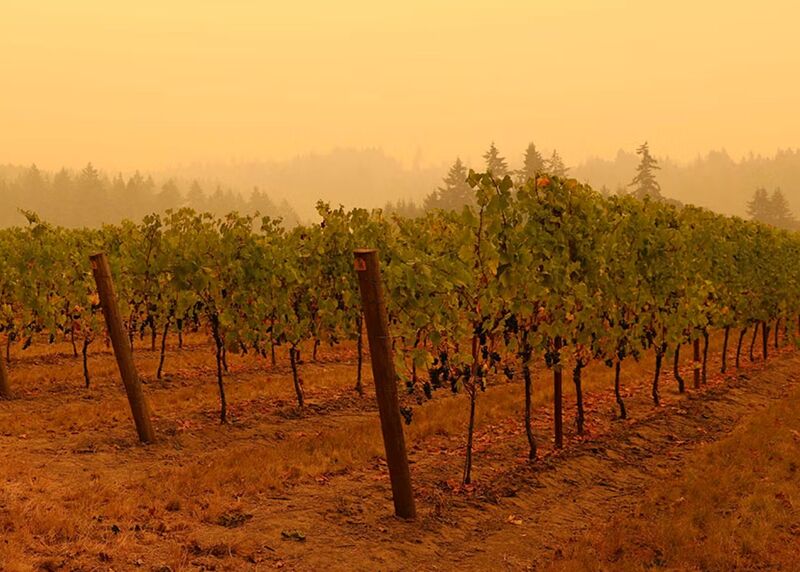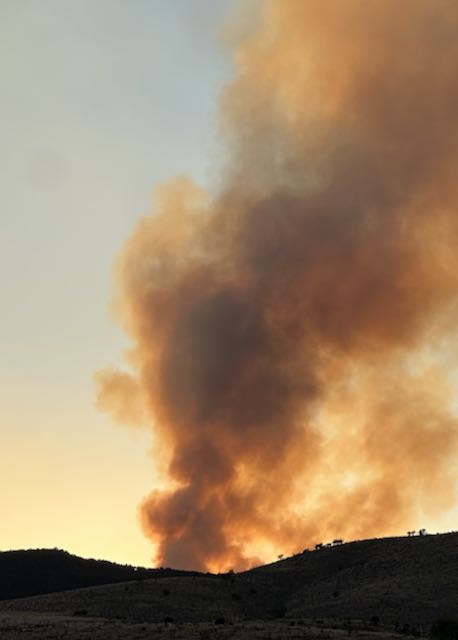
When does wildfire smoke taint grapes and wine?
How much wildfire smoke does it take to taint grapes and the resulting wine? This is an ever-growing and evolving topic for growers and wineries worldwide. Exacerbated by climate change, large destructive wildfires have become more common, and wine country is not exempt.
Locally, this subject became more topical in early July, when several wildfires broke out in western Colorado and eastern Utah, including in our vicinity at the Black Canyon. It didn’t help that much of western Colorado, including our Delta County, was experiencing an extreme drought.
During July, our valley was cloaked in a smoky orange haze. By early August, many of the fires were in different stages of containment, and most of the smoke in the valley had abated.
However, smoke came and went as the winds of the weather blew.

Take the Leroux Creek fire, which sprang forth on Sunday, August 3.
Late in the day, a billowing cloud on the other side of the hill from our property appeared. A nightmare fueled by drought comes to fruition in the blink of an eye.
Luckily for us, the winds took the fire in another direction. Governor Polis declared a verbal disaster emergency on the 4th. The fire grew initially to 700 acres but was contained within a week.
In the long run, damage to personal property was limited. A hearty thank you to our brave firefighters and volunteers was in order!
With the local fires and others in California making the news, I began asking myself whether my young grapes would be negatively impacted.
Not surprisingly, it’s a complicated question with a variety of answers. When smoke occurs at a level that impacts grapes, it is referred to as smoke taint. In essence, volatile phenolic compounds in wildfire smoke cling to grape skins and bind with sugars in the fruit.
Surprisingly, smoke taint isn’t harmful to the health of the vines or grapes, but it can dramatically affect how they taste, and the wine made from them.
I’ll keep the smoke taint examination simple, highlighting several salient points: timing, duration, and level and type of exposure.
For grapes, the younger they are, the more resistant they are to smoke taint. Grapes are most vulnerable during véraison, when grapes accumulate sugar, making them more susceptible to harmful compounds. In western Colorado, this typically occurs over a one to three-week period from late July through August.
The grape skin is the first line of defense, absorbing compounds in the smoke. Therefore, in winemaking, red wine is more susceptible to the taint because the juice is fermented on the skins. In contrast, white grape juice is pressed off the skins before fermentation, limiting taint. However, depending on the level of smoke absorbed, sugars can also be affected.
Not all smoke is equal. Fresh smoke at higher levels is more harmful than older smoke at lower levels. Duration and intensity are also key. Even low levels of smoke over an extended period of weeks or months, especially during and after véraison, can be harmful.
In addition, different phenolic compounds associated with the fuel being consumed by the fire affect grapes differently. Here, things become complicated, where a layperson such as me dare not tread.
Vineyard managers and winemakers can now send their grapes to labs to test for smoke taint. Methods have been developed to address this issue in the winery.
For the time being, the occurrence, timing, and location of the wildfires in western Colorado haven’t tainted my grapes. However, here in the North Fork Valley, where extreme drought persists, we are keeping our fingers crossed that existing fires continue to be contained and new, larger fires don’t erupt.
Véraison is underway…

